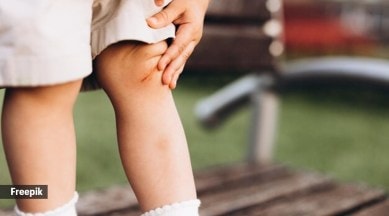📣 For more lifestyle news, click here to join our WhatsApp Channel and also follow us on Instagram
How does arthritis affect children
According to Dr Ashish Ranade, a senior consultant in pediatric orthopedics at Surya Mother and Child Super Speciality Hospital in Pune, India, the number of Juvenile idiopathic arthritis (JIA) cases has been gradually increasing. Approximately 4-5 new cases are reported each month.

Juvenile arthritis, often referred to as JA, is a challenging and often misunderstood condition that affects children and adolescents worldwide. While arthritis is typically associated with the elderly, it’s crucial to recognise that young individuals can also grapple with this painful and debilitating ailment.
JA is an umbrella term encompassing a group of chronic autoimmune diseases characterised by joint inflammation. Unlike arthritis in adults, JA doesn’t discriminate by age and can impact children ranging from toddlers to teenagers. This presents a unique set of challenges for both the young patients and their families, as it disrupts the normal rhythm of growing up.
monthly limit of free stories.
with an Express account.
Juvenile idiopathic arthritis (JIA), formerly known as juvenile rheumatoid arthritis, is the most prevalent type of JA among children under 16.
According to Dr Ashish Ranade, a senior consultant in pediatric orthopedics at Surya Mother and Child Super Speciality Hospital in Pune, India, the number of JIA cases has been gradually increasing. Approximately 4-5 new cases are reported each month. While the exact reasons behind this surge remain uncertain, environmental factors may play a significant role in the upswing of JIA cases.
Dr Ranade explains that JIA leads to stiffness, swelling, and pain in the joints of children, potentially causing developmental challenges as it erodes bone and cartilage.
“JIA can manifest in various subcategories, including oligoarticular (affecting large joints like knees and ankles), polyarticular (involving five or more joints, often symmetrically), and systemic onset (characterised by symptoms like fever, rashes, swollen glands, and fatigue),” he added.
Symptoms and diagnosis
Common symptoms of juvenile arthritis include morning stiffness and joint inflammation, often accompanied by warmth due to inflammation. “In some cases, it may also lead to eye inflammation, resulting in blurred vision, dryness, or conjunctivitis. Fatigue, suboptimal weight gain, delayed growth, and shorter stature are other potential indicators, along with high fever, a pervasive body rash, and swollen lymph nodes,” Dr Ranade noted.
Diagnosing JIA is not straightforward, as there is no single medical evaluation for it. Doctors, particularly rheumatologists, rely on a comprehensive approach, involving a thorough examination of medical history, clinical assessments, blood tests, and imaging. Eye examinations and joint fluid aspirations may also be necessary for a conclusive diagnosis.
Causes and risk factors
Juvenile arthritis is classified as an autoimmune disorder, where the body’s immune system mistakenly attacks its own cells and tissues. However, the exact causes of this condition remain elusive.
Dr Ranade pointed out that JIA often exhibits a hereditary pattern in children carrying the HLA DR4 gene. Genetic predisposition may be triggered by specific environmental factors or viruses, although the exact triggers remain unidentified.
“While most JIA patients can achieve complete recovery with proper treatment and management, some children may experience lifelong complications. These complications can include stunted growth, irregular bone structures, bone thinning leading to osteoporosis, psoriasis, and glaucoma. In severe cases, patients may develop cardiac or renal complications,” he highlighted.
Prevention and treatment
Juvenile arthritis cannot be prevented, and there is no cure for it. However, Dr Ranade said that early diagnosis and treatment can significantly improve a child’s prognosis. Treatments are tailored to the child’s age and often include physical therapy such as aquatic exercises, swimming, and cycling.
“Medical treatments for JIA typically involve disease-modifying antirheumatic medications designed to manage disease progression. In more severe cases, newer medications known as “biologicals” are used to regulate the body’s immune response. Due to advances in medication, surgical intervention is rarely required, especially for joint deformities,” he explained.
Timely diagnosis and a holistic approach to treatment are essential in helping these young patients lead fulfilling lives despite the challenges posed by JIA.
📣 For more lifestyle news, follow us on Instagram | Twitter | Facebook and don’t miss out on the latest updates!
📣 For more lifestyle news, click here to join our WhatsApp Channel and also follow us on Instagram